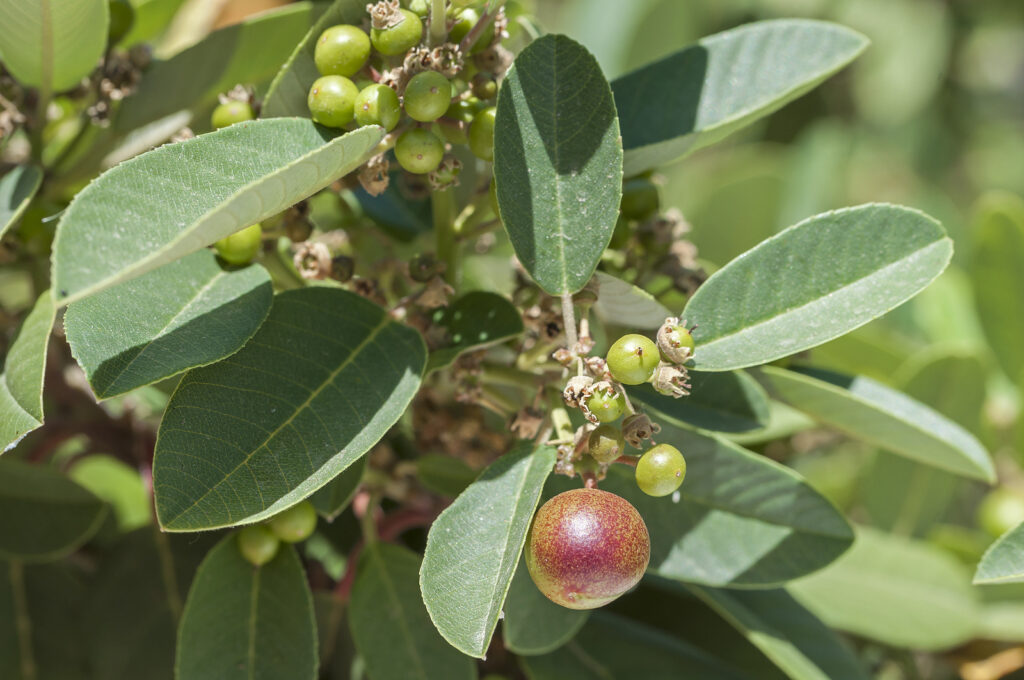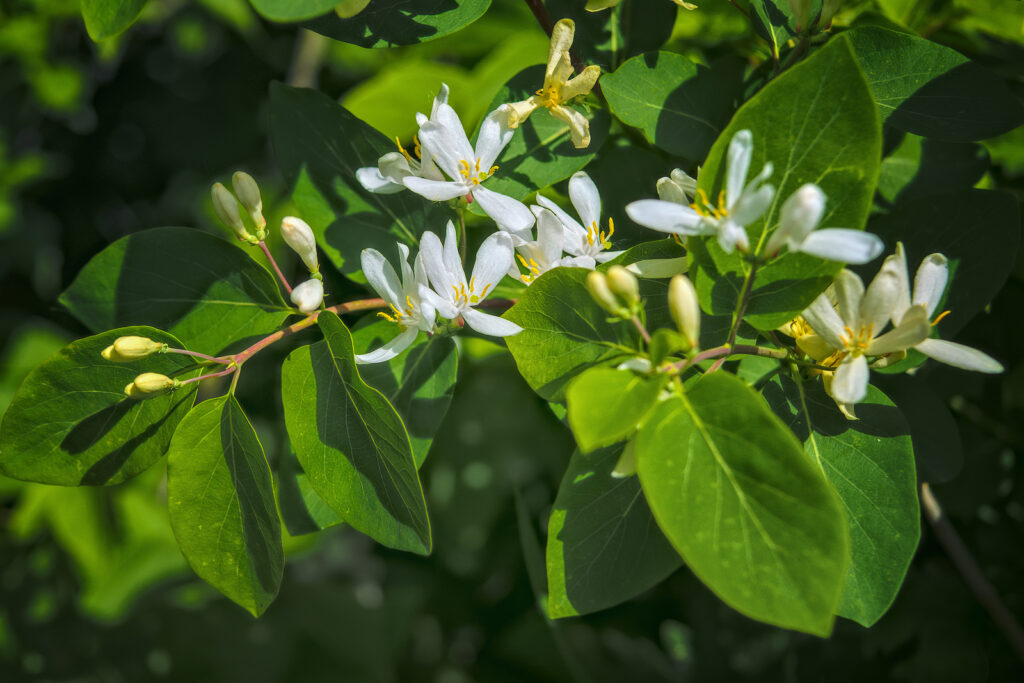Rhamnus–commonly called buckthorn–is a genus of evergreen and deciduous shrubs that are grown for their foliage. Rhamnus are dense spreading slightly rounded shrubs that are suited for shrub borders, background plantings, and informal hedges.
Rhamnus produce tiny cup-shaped flowers in racemes or umbel-like clusters. The flowers are often fragrant and usually yellowish-white, greenish-white, or white. Pea-size berries follow the flowers and attract birds.
Rhamnus is a genus of 125 species that are mostly native to woodland and scrub in the Northern Hemisphere.

Get to know Rhamnus
- Plant type: Evergreen or deciduous shrubs or trees
- Growing zones and range: Zones 2 to 8
- Hardiness: Hardy to Zone 2
- Height and width: 12-18 feet (3.7-5.5m) tall with an equal spread
- Growth rate: Moderate
- Form and habit: Rounded and spreading
- Foliage: The 2 inch (5.1cm) shiny dark green leaves that turn yellow in fall
- Flowers: Tiny clustered inconspicuous pale flowers
- Fruits: .3 inch (.8cm) berries that change from green to yellow and red, finally becoming black when fully ripe in late summer and fall
- Bloom time: Early summer
- Uses: Background plantings, hedges
- Common name: Buckthorn, coffeeberry
- Botanical name: Rhamnus
- Family name: Rhamnaceae
- Origin: Widely distributed in the Northern hemisphere
Where to plant Rhamnus
- Plant Rhamnus in full sun or light shade.
- Plant Rhamnus in almost any soil, including very wet ground.
When to plant Rhamnus
- Set container-grown Rhamnus in the garden in spring or autumn.
- Existing plants can be layered or softwood cuttings can be started in summer.

Planting and spacing Rhamnus
- To plant a Rhamnus hedge, plant 3-4 foot (.9-1.2m) plants 2-2.5 feet (.6-.8m) apart.
- Be sure to cut Rhamnus back to 1.5-2 feet (.5m) after planting to ensure satisfactory growth.
How to water and feed Rhamnus
- Give Rhamnus moderate water.
- Feed Rhamnus with an all-purpose organic fertilizer in spring.
How to care for Rhamnus
- Prune Rhamnus to restrict growth in early spring before new growth starts, so that the current season’s stems can produce fruit.
Rhamnus pests and diseases
- Rhamnus are susceptible to birds who devour the berries, and, unfortunately, disseminate the seeds over a wide area so that in some sections this plant has become a weed.
Rhamnus propagation
- Home propagation of R. franǵula columnaris species is prohibited since it is a patented plant, but the ordinary Rhamnus can be started from softwood cuttings of young growth in late spring or summer, or from hardwood cuttings of dormant leafless growth in late fall or winter.
- Rhamnus can be propagated by forcing a branch to grow roots by the method known as ground layering.

Rhamnus varieties to grow
- Rhamnus alaternus, Italian buckthorn, evergreen shrub. Fast, dense growth to 12-20 feet (3.7-6.1m) or more, with equal spread. Oval, shiny bright green leaves to 2 inches (5.1cm) long. Easily trained as single- or multi-trunked small tree. Takes well to shearing, shaping. Black fruits. ‘Variegata’ (‘Argenteo-variegata’) grows 6-8 feet (1.8-2.4m) tall, has creamy-edged foliage that looks striking against dark background (if branches with plain green leaves appear, cut them out or they’ll quickly take over).
- R. californica, Coffeeberry, evergreen shrub. Basic species is a variably upright plant to 15 feet (4.6m), with 3 inch (7.6cm), glossy, oval leaves; it may be sold by specialists in western native plants, but two named selections are more often planted. ‘Eve Case’ is compact, rounded to 4-8 feet (1.2-2.4m) high and wide; ‘Seaview’, to 6-8 feet (1.8-2.4m) wide, can be kept to 1.5 feet (.5m) high if upright growth is pinched out. Both have broadly oval leaves to 6 inches (15.2cm) long and cherry-size fruits that turn from green to red to black.
- R. cathartica, Common buckthorn, deciduous shrub or small tree. To 15-25 feet (4.6-7.6m) tall and wide. Glossy green, elliptical or oval leaves to 2.5 inches (6.4cm) long. Foliage drops late in season; fall color is poor. Short twigs often spine tipped. Black fruits. Tolerates drought, poor soil, wind. Useful hedge or small tree in coldest, driest regions. Full sun.
- R. franǵula, alder buckthorn, deciduous shrub or small tree. To 10-12 feet (3.1-3.7m)—possibly 18 feet (5.5m)—tall and as wide. Oval or obovate leaves to 3 inches (7.6cm) long, glossy dark green turning yellow in autumn. Fruits turn from greenish yellow to red orange, dark red, and then black. ‘Columnaris’, tallhedge buckthorn, grows 12-15 feet (3.7-4.6m) tall, 4 feet (1.2m) wide. Set 2.5 feet (.8m) apart for a tight, narrow hedge that can be kept as low as 4 feet (1.2m).
- R. franǵula columnaris, New Tallhedge, grows 10-12 feet (3.1-3.7m) tall, but spreads to a width of only 4 feet (1.2m). It is an excellent plant for hedges and screens because its leaves appear early in spring and do not drop until late in fall.















